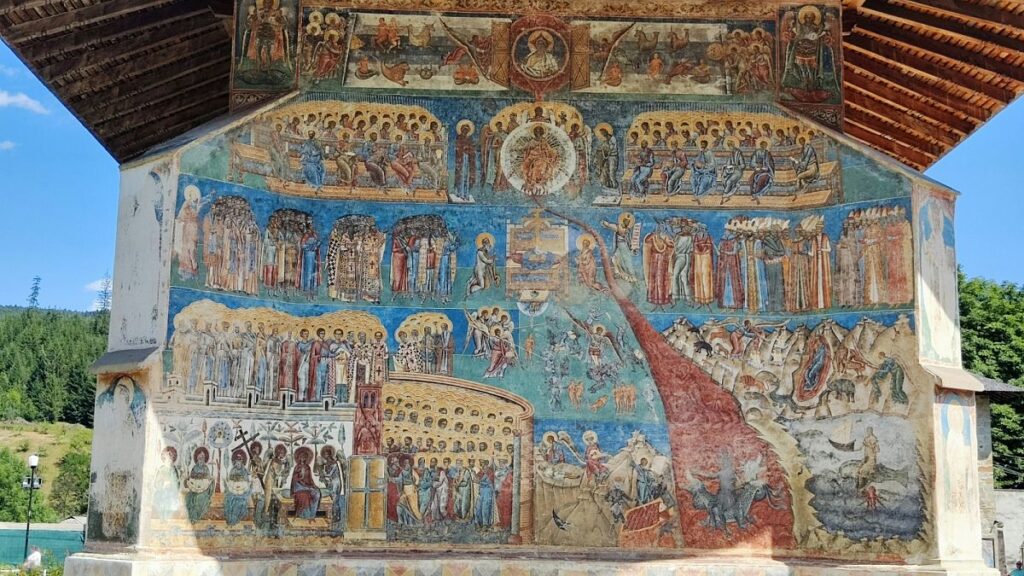Despite following calendars that are 13 days apart, the Eastern Orthodox and Western churches are celebrating Easter on the same Sunday this year.
Across Europe, people are gathering in spectacular religious buildings for the festivity today.
With captivating histories and artistic splendours, some of these incredible places of worship have also become key tourist attractions.
Here are some art-rich churches and monasteries in Europe that might not be on your radar. And, if you are into art history, you might even consider booking your next spring break around visiting them.
Gaze at giant frescoes in Georgia’s Gelati Monastery
The Gelati Monastery complex in Georgia’s Imereti region sits high on a hillside with lofty views over a lush valley.
But the real treasures lie inside the gracefully proportioned beige stone buildings, the oldest of which dates from 1106.
The churches’ interiors are a symphony of rich colour, with every inch of the walls and domed ceilings covered in vivid frescoes.
A colossal Virgin Mary gazes down from a gilded apse, bejewelled angels pose majestically, and stoic saints sit statue-like atop enormous columns.
Constructed under the direction of two kings of Georgia, the monastery is a UNESCO World Heritage Site.
Marvel at Romania’s Painted Monasteries
In Romania’s northern Bucovina region, a collection of 15th and 16th-century monasteries draws visitors with their eye-catching exteriors.
Known as the Painted Monasteries, their walls are covered in jewel-coloured frescoes of Orthodox saints and prophets, angels and demons, and scenes of heaven and hell.
Moldovița Monastery bears an epic scene of the Siege of Constantinople, while Voronet Monastery, known as the ‘Sistine Chapel of the East’, is famed for its intense shade of ‘Voronet Blue’.
Sucevita Monastery has one of the most dramatic scenes. Ladder to Paradise depicts red-winged angels helping the righteous up to heaven, while sinners slip through the rungs towards the leering devils in hell.
Peek into Padua’s Scrovegni Chapel
The northern Italian city of Padua is home to one of the medieval master Giotto’s most famed works.
The Scrovegni Chapel is decorated inside with fresco cycles by the artist, completed around 1305.
The masterpiece is considered to mark a pivotal moment in Western art, revolutionising spatial representation and heralding a more naturalistic and expressive style.
Giotto’s figures are imbued with emotion: the Virgin Mary and Mary Magdalene, distraught as Christ is lowered from the cross; a raging rabble of Roman soldiers; and astonished witnesses of Jesus’ miracles.
It also contains what is thought to be the first kiss in the history of art, as Anne (the Virgin Mary’s mother) and her husband Joachim embrace tenderly on hearing they are to have a child.
Dotted around Padua are seven other religious or secular building complexes that house equally exquisite 14th-century fresco cycles and are a collective UNESCO World Heritage Site along with the chapel.
Be mesmerised by mosaics in Palermo’s Palatine Chapel
Sicily’s capital city, Palermo, is home to a unique architectural style known as Arab-Norman. One of the prime examples of the 12th-century fusion is the Palatine Chapel located inside the Royal Palace.
Commissioned by the Norman king Roger II of Sicily, the chapel is like a giant treasure trove lined with shimmering golden mosaics by Byzantine artists. Scenes include depictions of graceful saints with elongated proportions and flowing drapery.
What defines the building as part of the distinct Arab-Norman style is the striking muqarnas ceiling above.
This highly ornate, three-dimensional structure of intricate geometric layers was a design likely brought over from North Africa, and now only found in Sicily.
Read the full article here






